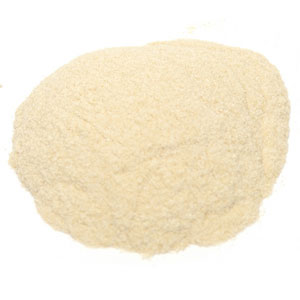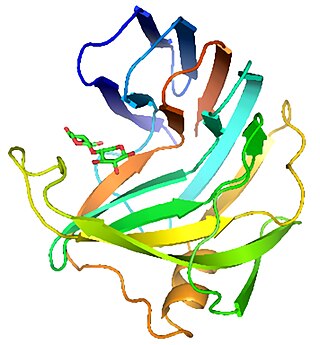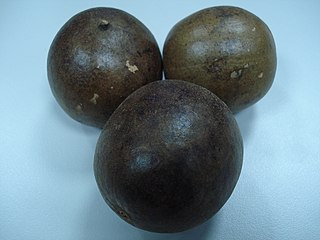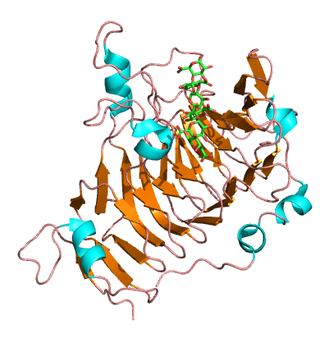Related Research Articles

A cell wall is a structural layer that surrounds some cell types, found immediately outside the cell membrane. It can be tough, flexible, and sometimes rigid. Primarily, it provides the cell with structural support, shape, protection, and functions as a selective barrier. Another vital role of the cell wall is to help the cell withstand osmotic pressure and mechanical stress. While absent in many eukaryotes, including animals, cell walls are prevalent in other organisms such as fungi, algae and plants, and are commonly found in most prokaryotes, with the exception of mollicute bacteria.

Orange juice is a liquid extract of the orange tree fruit, produced by squeezing or reaming oranges. It comes in several different varieties, including blood orange, navel oranges, valencia orange, clementine, and tangerine. As well as variations in oranges used, some varieties include differing amounts of juice vesicles, known as "pulp" in American English, and "(juicy) bits" in British English. These vesicles contain the juice of the orange and can be left in or removed during the manufacturing process. How juicy these vesicles are depend upon many factors, such as species, variety, and season. In American English, the beverage name is often abbreviated as "OJ".

An amylase is an enzyme that catalyses the hydrolysis of starch into sugars. Amylase is present in the saliva of humans and some other mammals, where it begins the chemical process of digestion. Foods that contain large amounts of starch but little sugar, such as rice and potatoes, may acquire a slightly sweet taste as they are chewed because amylase degrades some of their starch into sugar. The pancreas and salivary gland make amylase to hydrolyse dietary starch into disaccharides and trisaccharides which are converted by other enzymes to glucose to supply the body with energy. Plants and some bacteria also produce amylase. Specific amylase proteins are designated by different Greek letters. All amylases are glycoside hydrolases and act on α-1,4-glycosidic bonds.

Plant pathology or phytopathology is the scientific study of plant diseases caused by pathogens and environmental conditions. Plant pathology involves the study of pathogen identification, disease etiology, disease cycles, economic impact, plant disease epidemiology, plant disease resistance, how plant diseases affect humans and animals, pathosystem genetics, and management of plant diseases.

Pectin is a heteropolysaccharide, a structural acid contained in the primary lamella, in the middle lamella, and in the cell walls of terrestrial plants. The principal chemical component of pectin is galacturonic acid which was isolated and described by Henri Braconnot in 1825. Commercially produced pectin is a white-to-light-brown powder, produced from citrus fruits for use as an edible gelling agent, especially in jams and jellies, dessert fillings, medications, and sweets; and as a food stabiliser in fruit juices and milk drinks, and as a source of dietary fiber.

An exoenzyme, or extracellular enzyme, is an enzyme that is secreted by a cell and functions outside that cell. Exoenzymes are produced by both prokaryotic and eukaryotic cells and have been shown to be a crucial component of many biological processes. Most often these enzymes are involved in the breakdown of larger macromolecules. The breakdown of these larger macromolecules is critical for allowing their constituents to pass through the cell membrane and enter into the cell. For humans and other complex organisms, this process is best characterized by the digestive system which breaks down solid food via exoenzymes. The small molecules, generated by the exoenzyme activity, enter into cells and are utilized for various cellular functions. Bacteria and fungi also produce exoenzymes to digest nutrients in their environment, and these organisms can be used to conduct laboratory assays to identify the presence and function of such exoenzymes. Some pathogenic species also use exoenzymes as virulence factors to assist in the spread of these disease-causing microorganisms. In addition to the integral roles in biological systems, different classes of microbial exoenzymes have been used by humans since pre-historic times for such diverse purposes as food production, biofuels, textile production and in the paper industry. Another important role that microbial exoenzymes serve is in the natural ecology and bioremediation of terrestrial and marine environments.

Pectic acid, also known as polygalacturonic acid, is a water-insoluble, transparent gelatinous acid existing in over-ripe fruit and some vegetables. It is a product of pectin degradation in plants, and is produced via the interaction between pectinase and pectin In the early stage of development of fruits, the pectic substance is a water-insoluble protopectin which is converted into pectin by the enzyme protopectinase during ripening of fruit. In over-ripe fruits, due to the presence of pectic methyl esterase enzyme, the pectin gets largely converted to pectic acid which is water-insoluble. Due to this reason both immature and over-ripe fruits are not suitable for making jelly and only ripe fruits are used.

Finings are substances that are usually added at or near the completion of the processing of making wine, beer, and various nonalcoholic juice beverages. They are used to remove organic compounds, either to improve clarity or adjust flavor or aroma. The removed compounds may be sulfides, proteins, polyphenols, benzenoids, or copper ions. Unless they form a stable sediment in the final container, the spent finings are usually discarded from the beverage along with the target compounds that they capture.
Saprobionts are organisms that digest their food externally and then absorb the products. This process is called saprotrophic nutrition. Fungi are examples of saprobiontic organisms, which are a type of decomposer.

Endo-1,4-β-xylanase is any of a class of enzymes that degrade the linear polysaccharide xylan into xylose, thus breaking down hemicellulose, one of the major components of plant cell walls:

Siraitia grosvenorii, also known as monk fruit, monkfruit, luohan guo, or Swingle fruit, is a herbaceous perennial vine of the gourd family, Cucurbitaceae. It is native to southern China. The plant is cultivated for its fruit extract, called mogrosides, which creates a sweetness sensation 250 times stronger than sucrose. Mogroside extract has been used as a low-calorie sweetener for drinks and in traditional Chinese medicine.

β-Glucosidase is an enzyme that catalyses the following reaction:

Pectinesterase (EC 3.1.1.11; systematic name pectin pectylhydrolase) is a ubiquitous cell-wall-associated enzyme that presents several isoforms that facilitate plant cell wall modification and subsequent breakdown. It catalyzes the following reaction:
Pectin lyase is a polysaccharide enzyme with a complex structure that is present in plant cell walls. It has a significant role in pectin degradation and different biotechnological and industrial applications. It can be found in different organisms.

The juice vesicles, also known as citrus kernels, of a citrus fruit are the membranous content of the fruit's endocarp. The vesicles contain the juice of the fruit and appear shiny and sacklike. Vesicles come in two shapes: the superior and inferior, and these are distinct. Citrus fruit with more vesicles generally weighs more than those with fewer vesicles. Fruits with many segments, such as the grapefruit or pomelo, have more vesicles per segment than fruits with fewer segments, such as the kumquat and mandarin. Each vesicle in a segment in citrus fruits has approximately the same shape, size, and weight. About 5% of the weight of an average orange is made up of the membranes of the juice vesicles.

Rhamnogalacturonan-II (RG-II) is a complex polysaccharide component of pectin that is found in the primary cell walls of dicotyledonous and monocotyledonous plants and gymnosperms. It is supposed to be crucial for the plant cell wall integrity. RG-II is also likely to be present in the walls of some lower plants. Its global structure is conserved across vascular plants, albeit a number of variations within the RGII side chains have been observed between different plants. RG-II is composed of 12 different glycosyl residues including D-rhamnose, D-apiose, D-galactose, L-galactose, Kdo, D-galacturonic acid, L-arabinose, D-xylose, and L-aceric acid, linked together by at least 21 distinct glycosidic linkages. Some resides are further modified via methylation and acetylation. It moreover supports borate mediated cross-linking between different RGII side-chain apiosyl residues. The backbone consists of a linear polymer of alpha-1,4-linked D-galactopyranosiduronic acid. RG-II can be isolated from different sources, such as apple juice and red wine.

Endo-polygalacturonase (EC 3.2.1.15, pectin depolymerase, pectolase, pectin hydrolase, and poly-α-1,4-galacturonide glycanohydrolase; systematic name (1→4)-α-D-galacturonan glycanohydrolase (endo-cleaving)) is an enzyme that hydrolyzes the α-1,4 glycosidic bonds between galacturonic acid residues:
Solid state fermentation (SSF) is a biomolecule manufacturing process used in the food, pharmaceutical, cosmetic, fuel and textile industries. These biomolecules are mostly metabolites generated by microorganisms grown on a solid support selected for this purpose. This technology for the culture of microorganisms is an alternative to liquid or submerged fermentation, used predominantly for industrial purposes.

Glucanases are enzymes that break down large polysaccharides via hydrolysis. The product of the hydrolysis reaction is called a glucan, a linear polysaccharide made of up to 1200 glucose monomers, held together with glycosidic bonds. Glucans are abundant in the endosperm cell walls of cereals such as barley, rye, sorghum, rice, and wheat. Glucanases are also referred to as lichenases, hydrolases, glycosidases, glycosyl hydrolases, and/or laminarinases. Many types of glucanases share similar amino acid sequences but vastly different substrates. Of the known endo-glucanases, 1,3-1,4-β-glucanase is considered the most active.

Extracellular enzymes or exoenzymes are synthesized inside the cell and then secreted outside the cell, where their function is to break down complex macromolecules into smaller units to be taken up by the cell for growth and assimilation. These enzymes degrade complex organic matter such as cellulose and hemicellulose into simple sugars that enzyme-producing organisms use as a source of carbon, energy, and nutrients. Grouped as hydrolases, lyases, oxidoreductases and transferases, these extracellular enzymes control soil enzyme activity through efficient degradation of biopolymers.
References
- ↑ Sakai T, Sakamoto T, Hallaert J, Vandamme EJ (1993). "Pectin, pectinase and protopectinase: production, properties, and applications". Advances in Applied Microbiology. 39: 213–94. doi:10.1016/s0065-2164(08)70597-5. PMID 8213306.
- ↑ Singh, Ram Sarup; Singh, Taranjeet; Pandey, Ashok (2019-01-01), Singh, Ram Sarup; Singhania, Reeta Rani; Pandey, Ashok; Larroche, Christian (eds.), "Chapter 1 - Microbial Enzymes—An Overview", Advances in Enzyme Technology, Biomass, Biofuels, Biochemicals, Elsevier, pp. 1–40, ISBN 978-0-444-64114-4 , retrieved 2021-10-20
- ↑ "Pectinase". Enzyme India. Archived from the original on 26 March 2010. Retrieved 26 March 2010.
- ↑ Melton, Laurence (2019). Encyclopedia of Food Chemistry (Volume 2 ed.). Elsevier. p. 271.
- 1 2 3 Saranaj, P; Naidu, M.A. (2014). "Microbial Pectinases: A Review". ResearchGate.
- ↑
- ↑ "BRENDA - Information on EC 3.2.1.15 - endo-polygalacturonase". brenda-enzymes.org. Retrieved 2021-10-20.
- ↑ Gummadi, Sathyanarayana N.; Manoj, N.; Kumar, D. Sunil (2007), Polaina, Julio; MacCabe, Andrew P. (eds.), "Structural and Biochemical Properties of Pectinases", Industrial Enzymes: Structure, Function and Applications, Dordrecht: Springer Netherlands, pp. 99–115, doi:10.1007/1-4020-5377-0_7, ISBN 978-1-4020-5377-1 , retrieved 2021-10-20
- ↑ "Pectinase". Enzyme India. Archived from the original on 26 March 2010. Retrieved 26 March 2010.
- ↑ Saranaj, P; Naidu, M.A. (2014). "Microbial Pectinases: A Review". ResearchGate.
- ↑ Rebello, Sharrel; Anju, Mohandas; Aneesh, Embalil Mathachan; Sindhu, Raveendran; Binod, Parameswaran; Pandey, Ashok (13 July 2017). "Recent advancement sin the production and application of microbial pectinases: an overview" (PDF). Reviews in Environmental Science and Bio/Technology. 16 (3): 381–394. doi:10.1007/s11157-017-9437-y. S2CID 90607593.